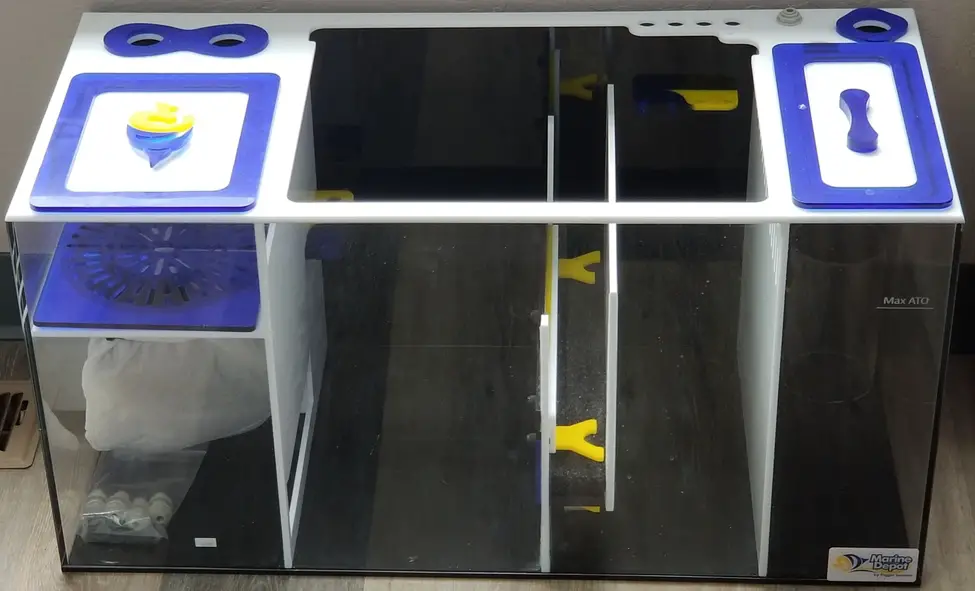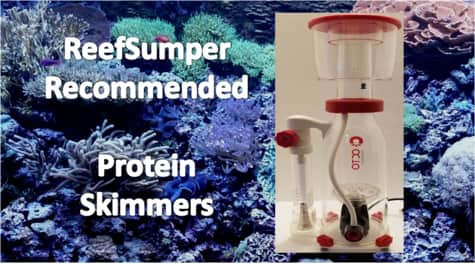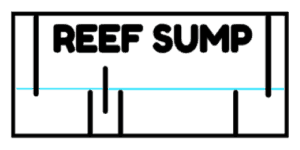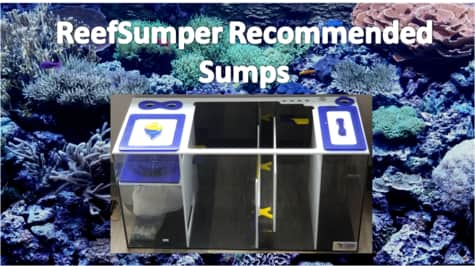
In my first reef tank, my 55-gallon origin tank, I didn’t initially run it with a sump and started with a canister filter. Eventually, I would end up coming to the light and added a sump to the 55-gallon tank. Since that first upgrade, I can confidently say that I wouldn’t even consider setting up a system without a sump unless it is a very small nano tank with frequent water changes planned. Over the years I’ve enjoyed planning, piecing together, and regularly maintaining my sumps. Below are some of my experiences with sumps and 10 advantages in no particular order on having a sump in your reef aquarium system.
1. Overall Stability
In reef-keeping success, stability is king. Stability in salinity, temperature, and water chemistry are the keys to the health and happiness of your system and livestock. Even a system with not so ideal parameters, if stable can support life over time. I’ve seen successful reef tanks where the owner does very little regular maintenance and water changes yet the fish and corals were alive and thriving. I will remark that most of these types of tanks had hardy fish and easy to care for coral that can thrive naturally in a bit of a dirty tank.
When a sump is part of a reef aquarium system, the overall water volume in the system increases in proportion to the size and water level in the sump. With more water volume, changes whether intended or accidental change the overall environment slower. Anything added to the system has less of an impact when there is greater water volume. If you have an automatic top-off system (ATO) installed and if it were to malfunction in the on setting, your entire ATO reservoir could potentially empty into the tank system. If you have a large volume of water in the system the additional freshwater in most cases won’t be enough to cause a catastrophic issue in the tank. Other things can happen like spilling something into the tank or overdosing. In those situations, the higher water volume will help prevent a catastrophic die-off.
Tunze Osmolator Auto Top Off System
2. A Place to Banish the Equipment
This is one of the biggest advantages for me. Most sumps are going to be located below the display tank or away from the tank in a fish room or other location. A well-stocked and beautifully rock-scaped display tank can be a true work of art. The existence of equipment within the aquarium, in my opinion, detracts from the natural look that a reef tank is usually trying to replicate. A sump gives the ability to take equipment out of the tank and relocate to a location that can be hidden and accessed only when needed or wanted. Skimmers, pumps, media reactors, and many other pieces of equipment can all be relocated to the sump.
I like to keep in-tank equipment and devices to a minimum as much as possible. I shoot for only having the slimmest overflow box possible for the application and just enough powerheads for the right flow for the tank. All other equipment I try to have in the sump or leave out of the system altogether. Having most of the equipment in the same location also helps with clutter and wire management. Wires can be bundled together and run in the same plane creating a cable highway to the outlet. It also makes it easier to ensure that the single bundle of wires is properly dripped looped before going into the outlet.
10 Aquarium Cord Management Accessories
3. Another Part of the Hobby to Show Off
A sump and the equipment driving the system is one of my favorite aspects of the reef-keeping hobby. Having a sump gives a whole other technical aspect to show off to family and friends. When having visitors at the home the display tank and its contents usually immediately draw the eyes and attention of the visitors. After having a look and explaining the fish and corals, the real fun begins as the aquarium stand doors open up. I’ve seen shock and awe appear on the faces of friends and family when they find out there is a tank (the sump) under the tank. It is very fulfilling to then explain the process of the water flowing from the tank into the sump and what each chamber is doing to the water and how it supports the life in the display tank. I like to go over each part of the sump as the water travels through it explaining in depth what each stage is doing. People are especially impressed with the refugium section and how having chaeto is like gardening as it grows and also provides a food source for the tank in pods. I think most people know about filters and heaters, but when they get to see the sump, it’s a real eye-opener. After showing friends my tank and set up I’ve had people inquire about setting up their own systems.
Another thing that having a sump has allowed me to do is teach my kids about biology, filtration, plumbing, and even engineering concepts. At the time of this writing, my kids are 6 and 8 years old. They often hang out with me when I’m working on the tanks and often ask about the various fish, corals, and equipment of the tank. My kids know what a protein skimmer does and how it functions which makes my heart happy. I think there will be many future conversations around biology and mechanics as they grow up around reef tanks.
4. Ease of Regular Maintenance
Having a sump greatly increases the ease of regular maintenance. Having most of the life support equipment centrally located makes it easy to inspect and remove equipment from the system for cleaning and maintenance. In a properly set up sump, regular maintenance is taken into account including being able to easily see the equipment and the ease of removing equipment for cleaning and maintenance. One consideration if you have a fish room, is to consider elevating your sump if possible. Not having to bend over or sit on the floor to service the components can be a great advantage. As I grow older that is the one complaint I have with under-the-tank sumps. Having to sit on the floor and repeatedly get up and down from the floor as I maintain the system can be hard on the back. Sumps can also be a great place to conduct water changes. It is often best practice to disrupt the display tank as infrequently as possible. Removing water from the sump and refilling in the sump is an easy way to remove a display disruption point.
With a sump involved, it can also be a good place to centrally collect detritus and remove it from the system. Here are two articles detailing how I’ve done this utilizing an inline pump and a Shop-Vac:
How to Make and Use an Aquarium Sump Waste Vacuum
How to Use a Shop-Vac to Deep Clean Your Aquarium Sump
5. Flexibility
Sumps provide you with great flexibility on how you can set up the life support systems of the tank. Different types of mechanical, biological, and chemical filtration all become possibilities with the addition of a sump. Sumps often have dedicated chambers and these chambers can be used in seemingly endless ways to keep your reef tank happy and healthy. In most of my sumps, I try to keep it simple having a chaeto refugium, GFO, and Carbon chemical filtration, an in-sump skimmer, and filter socks.
As issues pop up or some new cool technology hits the market, sumps give you the flexibility to try things out. One recent product to hit the market is filter rollers. These filters are continually like filter socks, but the roll advances new filter media as it gets used up making the need to change much less frequently than filter socks. Algae scrubbers are another example of equipment that can be incorporated into an existing sump. Algae scrubbers are a natural form of filtration where water passes through light and algae is grown. The algae growth process is a natural way of removing nitrates and phosphates from the tank. Biological media like Marine Pure Blocks can also be used in the sump to provide a very pores place for beneficial bacteria to populate.
If you are going to dose chemicals like 2 part in your system, the sump is a great place to do this. Slowly dosing chemicals in the sump give the chemicals more of a chance to mix into the water column and be less concentrated before making their way into the display tank. The same goes for an automatic top-off system. I usually will have my drip lines in my sump where I monitor the water level.
Sumps can also be used for other things too. If you have the appropriate room and chamber, a sump can be used as a timeout box for aggressive fish and coral. If there is room and you provide the right light, a chamber can even be converted into a frag holding section. I generally stick to using my sump for its intended purpose of filtering and cleaning water. I prefer to keep life to a minimum in the sump usually on keeping chaeto and microfauna in the refugium.
6. Ability to Run an In-sump Skimmer
My reef-keeping journey started with a CPR Bak-Pak II hang on the back skimmer. While this worked on occasion after continuous fiddling, I did not have the most positive experience with my first skimmer. I would eventually upgrade and add a sump to my 55-gallon origin tank and include an in-sump skimmer. What a change that was. The skimmer was much more efficient pulling loads more skimmate from the tank and worked flawlessly with hardly any regular tweaking. My first in-sump skimmer was an Eshops S-120 Snow Cone skimmer which I still use on my 22-gallon frag Clownfish tank. Unless something revolutionary comes on the market, I really don’t see myself using anything other than an in-sump skimmer in the future. From my experience, in sump skimmers are quieter, require less constant adjustment, and are more efficient in removing waste.

7. Increased Personal Knowledge and Skill
Having a sump has continuously increased my knowledge and skill with reef keeping. When I first upgraded my 55-gallon origin tank to a sump I had to plan on how to best accomplish adding a sump to the system with many constraints. One of the first constraints I encountered was that my tank was built with tempered glass and would shatter if attempting to drill. Before this, I had no idea even what tempered glass was and how to identify if the glass is tempered. Next, I had to find an alternative which was to use an overflow siphon tube overflow box. After that came pluming and return. I had very little experience with plumbing outside of simple home sink repair and unclogging. My stand also had very little room to work with so I had to find just the right sump and modify the stand to get it to fit. Ultimately, I was able to overcome all the challenges and get a sump installed on my 55-gallon tank. The lessons learned enabled me to move on to bigger systems and build them from the ground up in my next tanks.
8. Increased Aeration
Fish rely on highly oxygenated water to breathe and live well. Aeration happens when the water is mixed with air through movement and other methods. Having a sump in place will naturally help with the aeration of the tank water. As water is drained from the display tank to the sump, it often gets mixed with air as it continuously drains into the sump and either hits the surface of the water in the sump or agitates the water. Further aeration happens as the water moves between the champers. If a protein skimmer is in the system, the skimmer greatly aerates the water by mechanically mixing the water with air as it creates microbubbles. Finally, as the water returns to the display it often agitates the surface water of the tank giving yet another step in the water movement process that aerates the water.
How to Keep Micro Bubbles From Entering Your Display Aquarium
9. Noise Reduction
At one point in my reef-keeping history, I had a pair of very territorial Clownfish that were especially aggressive to anything that moved and came close to their territory in their tank. My solution was to set up a small 10-gallon nano tank in my bedroom for the Clownfish. I had a spare ten-gallon tank and a few other pieces of equipment to make a basic quarantine-style tank that I planned on building up over time. I set up the tank and it only lasted for about a week in the bedroom. I simply could not stand the sound the tank made including random variable sounds at all times of the day. I quickly broke down the tank and was able to re-home the pair of Clownfish. I learned a valuable lesson that my preference was to see the tank and not hear it as much as possible. Having a sump in a fish room or beneath the stand is a good way to stifle tank sound. When I built my 75-gallon tank I utilized a Herbie style drain and the system is very quiet and any unusual sounds are a quick notification that something is out of place.
10. The Ability to Incorporate a Refugium in the System
Many sumps include the ability to add a refugium into the overall reef aquarium system. I’ve found refugiums to be very beneficial in my tanks. I like to have a refugium with larger live rock pieces on the bottom and a full chamber of chaeto. Having healthy constantly growing chaeto in your refugium is the conversion of nitrates and phosphates manifesting in front of your eyes. Growing microalgae in a controlled section have kept algae out of my tank’s displays. A high-functioning refugium can also prevent large swings in PH between day and night time. PH is maintained when macroalgae growth and oxygen exchange is happening. This is why in my tanks I like to run my refugium lights on the opposite schedule of my main display lights.
Refugiums also provide a safe zone to populate a sustainable microfauna population including Copepods and Amphipods. A healthy population of microfauna increases the biodiversity of your tank which is thought to be very beneficial to the health of the overall reef tank. Micro fauna is like little janitors that clean in rock work and other parts of the tank that can’t be reached otherwise. There are many fish and corals that use microfauna as a food source. Having a refugium with pods has allowed me to keep Mandarin Gobies, which in my opinion are one of the most striking and peculiar fish in the hobby. As stated earlier, refugiums can also be used as a time-out penalty box when needed. I’ve also used refugiums to acclimate sensitive fish before adding them to the main display.
AlgaeBarn Live Copepods & Phytoplankton
POSEIDON’S FEAST LIVE COPEPODS: Imagine having a sustainable & diverse copepod population in your marine aquarium. Poseidon’s Feast contains 3000+ Premium LIVE Tigriopus and Tisbe Copepods ranging from nauplii to adult sizes.



